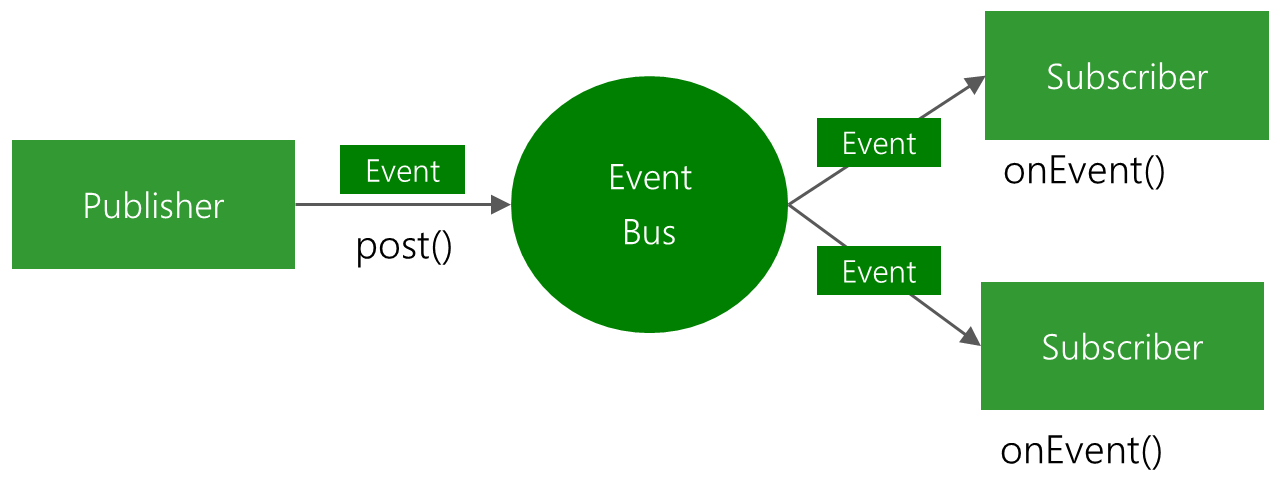上一篇,我们基本知道了EventBus的使用步骤,接下来先简单研究一下其中的源码。在分析源码之前,我们先回顾一下Java反射的知识点:
JAVA反射机制
基本定义:
JAVA反射机制是在运行状态中,对于任意一个类,都能够知道这个类的所有属性和方法;对于任意一个对象,都能够调用它的任意一个方法和属性;这种动态获取的信息以及动态调用对象的方法的功能称为java语言的反射机制。
Sun为提供的关于反射机制中的类:
java.lang.Class;
java.lang.reflect.Constructor;
java.lang.reflect.Field;
java.lang.reflect.Method;
java.lang.reflect.Modifier;
我们可以通过反射机制访问java对象的属性,方法,构造方法等。
(1)getDeclaredMethods()
获取所有的方法
(2)getDeclaredMethod(“方法名”,参数类型.class,……)
获得特定的方法
(3)getFields()则是返回类型中的所有公有属性
(4)getDeclaredField( )
获得特定的属性
JAVA反射的常规使用步骤
(1)得到要调用类的class
(2)得到要调用的类中的方法(Method)
(3)方法调用(invoke)
如下:
//实体类
public class Student {
private int age;
private String name;
public int getAge() {
return age;
}
public void setAge(int age) {
this.age = age;
}
public String getName() {
return name;
}
public void setName(String name) {
this.name = name;
}
public static void toString(int age,String name){
System.out.println("大家好,我叫"+name+",今年"+age+"岁");
}
//通过反射调用toString()方法
Class cls = Class.forName("chb.test.reflect.Student");
Method m = cls.getDeclaredMethod("toString",new Class[]{int.class,String.class});
m.invoke(cls.newInstance(),20,"chb")反射的基本知识我们知晓了,再来看看EventBus的一些基本知识:
首先对EventBus的有一个大局的认识,参考官方的介绍图如下:
EventBus中的观察者通常有四种订阅函数
(就是某件事情发生被调用的方法)
(1)、onEvent
(2)、onEventMainThread
(3)、onEventBackground
(4)、onEventAsync
这四种订阅函数都是使用onEvent开头的,它们的功能稍有不同,在介绍不同之前先介绍两个概念:
(1)告知观察者事件发生时通过EventBus.post函数实现,这个过程叫做事件的发布;
(2)观察者被告知事件发生叫做事件的接收,是通过下面的四种订阅函数实现的。
1 onEvent:如果使用onEvent作为订阅函数,那么该事件在哪个线程发布出来的,onEvent就会在这个线程中运行,也就是说发布事件和接收事件线程在同一个线程。使用这个方法时,在onEvent方法中不能执行耗时操作,如果执行耗时操作容易导致事件分发延迟。
2 onEventMainThread:如果使用onEventMainThread作为订阅函数,那么不论事件是在哪个线程中发布出来的,onEventMainThread都会在UI线程中执行,接收事件就会在UI线程中运行,这个在Android中是非常有用的,因为在Android中只能在UI线程中跟新UI,所以在onEvnetMainThread方法中是不能执行耗时操作的。
3 onEvnetBackground:如果使用onEventBackgrond作为订阅函数,那么如果事件是在UI线程中发布出来的,那么onEventBackground就会在子线程中运行,如果事件本来就是子线程中发布出来的,那么onEventBackground函数直接在该子线程中执行。
4 onEventAsync:使用这个函数作为订阅函数,那么无论事件在哪个线程发布,都会创建新的子线程在执行onEventAsync.源码分析
我们分析源码先从程序的入口开始,EventBus的入口是注册时开始, 即
EventBus.getDefault().register(this);
EventBus.getDefault()返回的是一个EventBus的实例,是一个单例模式:
static volatile EventBus defaultInstance;
/** Convenience singleton for apps using a process-wide EventBus instance. */
public static EventBus getDefault() {
if (defaultInstance == null) {
synchronized (EventBus.class) {
if (defaultInstance == null) {
defaultInstance = new EventBus();
}
}
}
return defaultInstance;
}这里实现单例采用了双重校验模式,提高的效率,也能防止并发可能产生的问题,同时defaultInstance采用了volatile 来修饰,避免了编译期相关值的修改。
然后看看注册方法:register
public void register(Object subscriber) {
//这里subscriber一般是this,在上篇文章中就指MainActivity.this
Class<?> subscriberClass = subscriber.getClass();
List<SubscriberMethod> subscriberMethods = subscriberMethodFinder.findSubscriberMethods(subscriberClass);//findSubscriberMethods()顾名思义就是通过类名去找类中的方法
synchronized (this) {
for (SubscriberMethod subscriberMethod : subscriberMethods) {
subscribe(subscriber, subscriberMethod);
}
}
}我们再来看看findSubscriberMethods(subscriberClass)方法:
List<SubscriberMethod> findSubscriberMethods(Class<?> subscriberClass) {
List<SubscriberMethod> subscriberMethods = METHOD_CACHE.get(subscriberClass);
//其中METHOD_CACHE是一个缓存的ConcurrentHashMap,Map<Class<?>, List<SubscriberMethod>> METHOD_CACHE = new ConcurrentHashMap<>();该Map以订阅的类名为key,订阅函数列表为value;
if (subscriberMethods != null) {
return subscriberMethods;
//首先判断缓存中是否已经包含该订阅类(即是否已经订阅过);
}
//第一次进来subscriberMethods肯定是Null
if (ignoreGeneratedIndex) {
subscriberMethods = findUsingReflection(subscriberClass);
} else {
subscriberMethods = findUsingInfo(subscriberClass);
}
if (subscriberMethods.isEmpty()) {
throw new EventBusException("Subscriber " + subscriberClass
+ " and its super classes have no public methods with the @Subscribe annotation");
} else {
METHOD_CACHE.put(subscriberClass, subscriberMethods);
return subscriberMethods;
}
}执行findUsingReflection(subscriberClass)后,会去执行findUsingReflectionInSingleClass方法,我们再看看####findUsingReflectionInSingleClass方法:
private void findUsingReflectionInSingleClass(FindState findState) {
Method[] methods;
try {
// This is faster than getMethods, especially when subscribers are fat classes like Activities
methods = findState.clazz.getDeclaredMethods(); //通过反射,获取该订阅类下面的所有申明的公共方法;
} catch (Throwable th) {
// Workaround for java.lang.NoClassDefFoundError, see https://github.com/greenrobot/EventBus/issues/149
methods = findState.clazz.getMethods();
findState.skipSuperClasses = true;
}
for (Method method : methods) {
int modifiers = method.getModifiers();
if ((modifiers & Modifier.PUBLIC) != 0 && (modifiers & MODIFIERS_IGNORE) == 0) {
Class<?>[] parameterTypes = method.getParameterTypes();
if (parameterTypes.length == 1) {
Subscribe subscribeAnnotation = method.getAnnotation(Subscribe.class);//获取添加了@Subscribe注解的函数
if (subscribeAnnotation != null) {
Class<?> eventType = parameterTypes[0];//获取订阅事件的类名
if (findState.checkAdd(method, eventType)) {
ThreadMode threadMode = subscribeAnnotation.threadMode();
findState.subscriberMethods.add(new SubscriberMethod(method, eventType, threadMode,
subscribeAnnotation.priority(), subscribeAnnotation.sticky()));
}
}
} else if (strictMethodVerification && method.isAnnotationPresent(Subscribe.class)) {
String methodName = method.getDeclaringClass().getName() + "." + method.getName();
throw new EventBusException("@Subscribe method " + methodName +
"must have exactly 1 parameter but has " + parameterTypes.length);
}
} else if (strictMethodVerification && method.isAnnotationPresent(Subscribe.class)) {
String methodName = method.getDeclaringClass().getName() + "." + method.getName();
throw new EventBusException(methodName +
" is a illegal @Subscribe method: must be public, non-static, and non-abstract");
}
}
}这样就完成了EventBus订阅者的注册;
我们回到register方法:
for (SubscriberMethod subscriberMethod : subscriberMethods) {
subscribe(subscriber, subscriberMethod, sticky, priority);
} 对每一个订阅方法,对其调用subscribe方法,进入该方法看看到底干了什么:
subscribe方法:
private void subscribe(Object subscriber, SubscriberMethod subscriberMethod, boolean sticky, int priority) {
subscribed = true;
//从订阅方法中拿到订阅事件的类型
Class<?> eventType = subscriberMethod.eventType;
//通过订阅事件类型,找到所有的订阅(Subscription),订阅中包含了订阅者,订阅方法
CopyOnWriteArrayList<Subscription> subscriptions = subscriptionsByEventType.get(eventType);
//创建一个新的订阅
Subscription newSubscription = new Subscription(subscriber, subscriberMethod, priority);
//将新建的订阅加入到这个事件类型对应的所有订阅列表
if (subscriptions == null) {
//如果该事件目前没有订阅列表,那么创建并加入该订阅
subscriptions = new CopyOnWriteArrayList<Subscription>();
subscriptionsByEventType.put(eventType, subscriptions);
} else {
//如果有订阅列表,检查是否已经加入过
for (Subscription subscription : subscriptions) {
if (subscription.equals(newSubscription)) {
throw new EventBusException("Subscriber " + subscriber.getClass() + " already registered to event "
+ eventType);
}
}
}
//根据优先级插入订阅
int size = subscriptions.size();
for (int i = 0; i <= size; i++) {
if (i == size || newSubscription.priority > subscriptions.get(i).priority) {
subscriptions.add(i, newSubscription);
break;
}
}
//将这个订阅事件加入到订阅者的订阅事件列表中
List<Class<?>> subscribedEvents = typesBySubscriber.get(subscriber);
if (subscribedEvents == null) {
subscribedEvents = new ArrayList<Class<?>>();
typesBySubscriber.put(subscriber, subscribedEvents);
}
subscribedEvents.add(eventType);
//这个是对粘性事件的,暂时不讨论
if (sticky) {
Object stickyEvent;
synchronized (stickyEvents) {
stickyEvent = stickyEvents.get(eventType);
}
if (stickyEvent != null) {
postToSubscription(newSubscription, stickyEvent, Looper.getMainLooper() == Looper.myLooper());
}
}
} 好了,到这里差不多register方法分析完了,大致流程就是这样的,我们总结一下:
1、找到被注册者中所有的订阅方法。
2、依次遍历订阅方法,找到EventBus中eventType对应的订阅列表,然后根据当前订阅者和订阅方法创建一个新的订阅加入到订阅列表
3、找到EvnetBus中subscriber订阅的事件列表,将eventType加入到这个事件列表。
所以对于任何一个订阅者,我们可以找到它的 订阅事件类型列表,通过这个订阅事件类型,可以找到在订阅者中的订阅函数。
register分析完了就分析一下post吧,这个分析完了,EventBus的原理差不多也完了…
post(Object event)
public void post(Object event) {
//这个EventBus中只有一个,差不多是个单例吧,具体不用细究
PostingThreadState postingState = currentPostingThreadState.get();
List<Object> eventQueue = postingState.eventQueue;
//将事件放入队列
eventQueue.add(event);
if (postingState.isPosting) {
return;
} else {
postingState.isMainThread = Looper.getMainLooper() == Looper.myLooper();
postingState.isPosting = true;
if (postingState.canceled) {
throw new EventBusException("Internal error. Abort state was not reset");
}
try {
while (!eventQueue.isEmpty()) {
//分发事件
postSingleEvent(eventQueue.remove(0), postingState);
}
} finally {
postingState.isPosting = false;
postingState.isMainThread = false;
}
}
} ost里面没有什么具体逻辑,它的功能主要是调用postSingleEvent完成的,进入到这个函数看看吧:
postSingleEvent(Object event, PostingThreadState postingState)
private void postSingleEvent(Object event, PostingThreadState postingState) throws Error {
Class<? extends Object> eventClass = event.getClass();
//找到eventClass对应的事件,包含父类对应的事件和接口对应的事件
List<Class<?>> eventTypes = findEventTypes(eventClass);
boolean subscriptionFound = false;
int countTypes = eventTypes.size();
for (int h = 0; h < countTypes; h++) {
Class<?> clazz = eventTypes.get(h);
CopyOnWriteArrayList<Subscription> subscriptions;
synchronized (this) {
//找到订阅事件对应的订阅,这个是通过register加入的(还记得吗....)
subscriptions = subscriptionsByEventType.get(clazz);
}
if (subscriptions != null && !subscriptions.isEmpty()) {
for (Subscription subscription : subscriptions) {
postingState.event = event;
postingState.subscription = subscription;
boolean aborted = false;
try {
//对每个订阅调用该方法
postToSubscription(subscription, event, postingState.isMainThread);
aborted = postingState.canceled;
} finally {
postingState.event = null;
postingState.subscription = null;
postingState.canceled = false;
}
if (aborted) {
break;
}
}
subscriptionFound = true;
}
}
//如果没有订阅发现,那么会Post一个NoSubscriberEvent事件
if (!subscriptionFound) {
Log.d(TAG, "No subscribers registered for event " + eventClass);
if (eventClass != NoSubscriberEvent.class && eventClass != SubscriberExceptionEvent.class) {
post(new NoSubscriberEvent(this, event));
}
}
} 这个方法有个核心方法 postToSubscription方法,进入看看吧
postToSubscription
private void postToSubscription(Subscription subscription, Object event, boolean isMainThread) {
//第一个参数就是传入的订阅,第二个参数就是对于的分发事件,第三个参数非常关键:是否在主线程
switch (subscription.subscriberMethod.threadMode) {
//这个threadMode是怎么传入的,仔细想想?是不是根据onEvent,onEventMainThread,onEventBackground,onEventAsync决定的?
case PostThread:
//直接在本线程中调用订阅函数
invokeSubscriber(subscription, event);
break;
case MainThread:
if (isMainThread) {
//如果直接在主线程,那么直接在本现场中调用订阅函数
invokeSubscriber(subscription, event);
} else {
//如果不在主线程,那么通过handler实现在主线程中执行,具体我就不跟踪了
mainThreadPoster.enqueue(subscription, event);
}
break;
case BackgroundThread:
if (isMainThread) {
//如果主线程,创建一个runnable丢入线程池中
backgroundPoster.enqueue(subscription, event);
} else {
//如果子线程,则直接调用
invokeSubscriber(subscription, event);
}
break;
case Async:
//不论什么线程,直接丢入线程池
asyncPoster.enqueue(subscription, event);
break;
default:
throw new IllegalStateException("Unknown thread mode: " + subscription.subscriberMethod.threadMode);
}
} 小结
直接反射调用;也就是说在当前的线程直接调用该方法;
(1)case MainThread:
首先去判断当前如果是UI线程,则直接调用;否则: mainThreadPoster.enqueue(subscription, event);把当前的方法加入到队列,然后直接通过handler去发送一个消息,在handler的handleMessage中,去执行我们的方法。说白了就是通过Handler去发送消息,然后执行的。
(2)case BackgroundThread:
如果当前非UI线程,则直接调用;如果是UI线程,则将任务加入到后台的一个队列,最终由Eventbus中的一个线程池去调用
executorService = Executors.newCachedThreadPool();。
(3) case Async:将任务加入到后台的一个队列,最终由Eventbus中的一个线程池去调用;线程池与BackgroundThread用的是同一个。
这么说BackgroundThread和Async有什么区别呢?
BackgroundThread中的任务,一个接着一个去调用,中间使用了一个布尔型变量handlerActive进行的控制。
Async则会动态控制并发。
因此,从完整的源码分析来看:register就是把当前类中匹配的方法,存入一个map,而post会根据实参(订阅事件的类型(由类名决定))去map查找进行反射调用。其实如果不用发布者,订阅者,事件,总线这几个词或许更好理解,以后大家提起EventBus,也可以说,就是在一个单例内部维持着一个map对象存储了一堆的方法;post无非就是根据参数去查找方法,进行反射调用。
参考致谢:
1 http://blog.csdn.net/yuanzeyao/article/details/38174537
2 http://blog.csdn.net/lmj623565791/article/details/40920453























 1万+
1万+

 被折叠的 条评论
为什么被折叠?
被折叠的 条评论
为什么被折叠?








